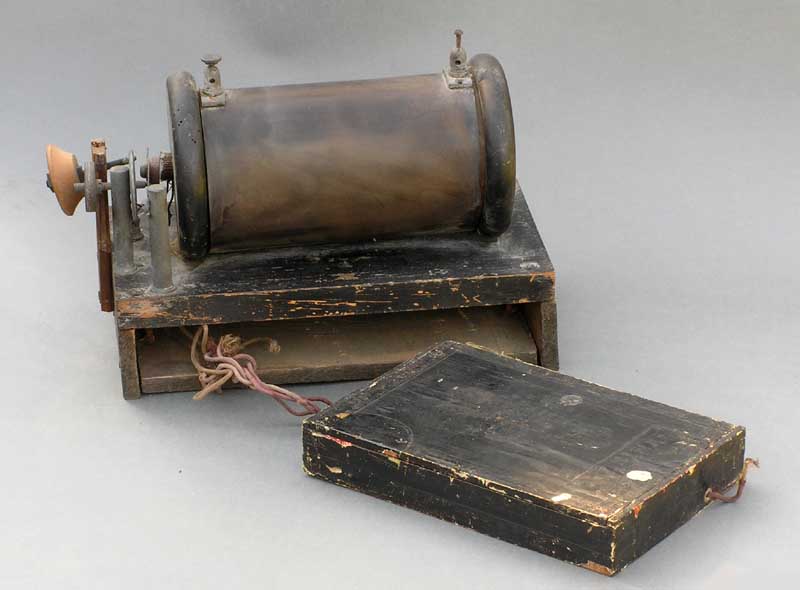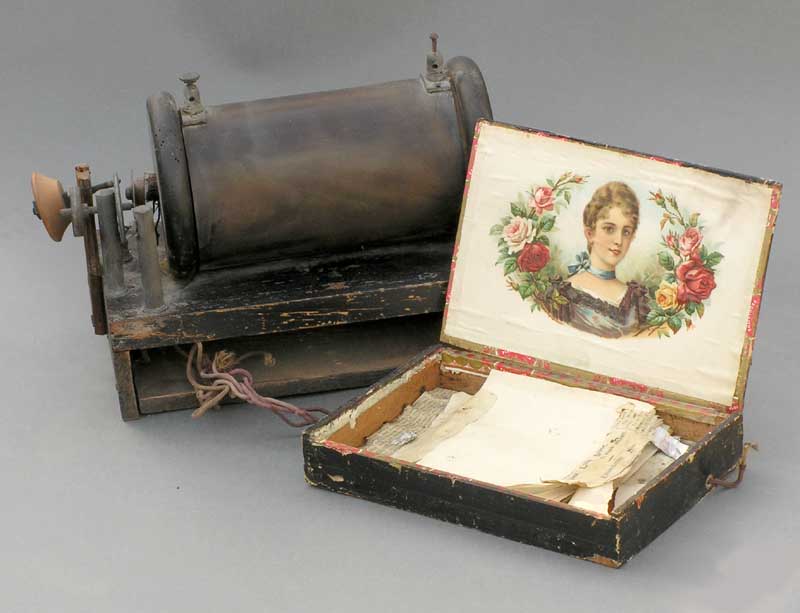
Gilbert W Tonkin (1889-1958) was an early wireless experimenter in Bristol. This article explains his early spark transmitter. It consisted of a 6-volt battery was used as a power source and a Branly coherer as a detector. The coil produced a 1/4″ spark. It is believed to have been built in 1908 or 1909.
The Branly Coherer is a glass tube, filled with iron, nickel or silver filings into which two copper wires are inserted so that they just do not touch. The ends of the tube are then plugged. This device only begins to conduct when strong RF fields are present. A tap is required to restore the non-conducting state. This is usually provided by a bell mechanism. Unfortunately this has not accompanied the transmitter. This transmitter probably operated at around 400 metres (750 kc/s) but the signal would have been very broad, from about 500 kc/s to 1200 kc/s.
Gilbert W. Tonkin was granted a licence for station TBX in 1910. All the pre WWI experimental licences included an ‘X’, usually as the last letter of the call. It is probable that this is the transmitting apparatus that was used, although a later card with the coil states that this was used to transmit 6 feet across a kitchen table! After WWI Gilbert was licenced as G5RQ and remained an active amateur well into the 50’s.

Here we can see the home made capacitor made by interleaving silver paper and note paper in a cigar box.
Below is an article by Gilbert Tonkin, from the October 1955 edition of the T&R Bulletin.
Early Experiences in Amateur Radio
By G. W. TONKIN (G5RQ, ex-TBX)
Following last year’s National Convention and Bristol Group’s N.F.D. hat-trick, Mr. Tonkin, who was one of the earliest wireless experimenters in Bristol, was invited to contribute these personal reminiscences of the early days of the hobby.
So far as is known the first contact over the sea was made by Marconi across the Bristol Channel from Lavernock Point, Penarth, to the Flatholm Island, a distance of 3 1/2 miles, on May 11, 1897. This was closely followed by a similar success from Bath to Salisbury (34 miles).
Early Interest
It was in 1909 that I first began to take notice of the fact that it was possible to send signals without visible means of connection. I made a transmitter with a 1/4in. spark coil powered by a 6 volt battery. Brass stair rods were used for capacities. For a receiver I used a Branly type coherer which was made from iron filings placed between two electrodes in a glass tube with two more stair rods for capacities. With this device signals were sent and received across the dining room table. The date was February 3, 1909. On another occasion, a volt meter was successfully used as an indicator.
Later on, I found that two friends of mine – Reggie Cox and Norman Driver – were also experimenting and I joined forces with them. I can recall that we established communication between Cox’s workshop and the coach house. On that occasion we used some sort of vertical aerial. Various coherers were used, one of which was a piece of mirror with a scratch across the silver back.
Licences
Things went on for about a year when I discovered that a licence was necessary. I pointed this out to my two collaborators who received the news with derision. Notwithstanding this, I applied for a licence early in 1910 and after much correspondence it arrived towards the end of that year, designating my station with the call-sign TBX. All experimental call-signs had an X in them, usually at the end. Cox and Driver followed my example and became CDX and DXX respectively.
There was one period when our licences restricted us to working certain specified stations and no others. We were glad it did not last long.
I was not the first in the field in Bristol, however, as Charles H. Tilsley had obtained a licence in June, 1905. He used a 4in. spark coil with the usual Branly type coherer and succeeded in transmitting signals a distance of about one mile across Bristol. Unfortunately he knew no Morse and did not continue his experiments. What a pity! Other early experimenters in the area were Mr. Sharp (GSX) and Mr. Davis, grandfather of John F. Davis (G3GVJ), but I have no record of their activities.
No fee was charged for licences and there was no examination of any sort, but if an applicant was within 10 miles of the coast, power was limited to 20 watts. Elsewhere, as much as 1/2 kW was often permitted.
It was of course necessary to make most things. I even made a Bell type telephone wound with No. 47 wire to a resistance of 1000 ohms.
On October 31, 1912, we had the opportunity of using a pair of commercially made transmitters and receivers at a bazaar in Bristol where we sent and received messages over a distance of 300ft at sixpence a time. This outfit was listed in the A. W. Gamage catalogue of 1907.
At about this time we began to use various combinations of crystals such as zincite/bornite, galena/graphite, zincite/copper pyrites, etc., for reception. Tuning was also started. Transmitter tuning helixes were made of 1/4in. brass rod wound into a huge coil. Leyden jars made of thin glass tumblers and tin foil acted as condensers.
My first aerial, erected in 1912, was a four wire horizontal about 25ft high. A 1in. spark coil running off a 6 volt accumulator was used as the transmitter. As this entailed a lot of charging, I put the 105 volt a.c. mains into the primary of the spark coil, via the break and a bank of carbon lamps in series parallel and it worked! The then 93 cycles of the Bristol a.c. mains worked in perfect harmony with the break. There was a great deal of ” try it and see if it works ” in those days.
Although comparatively small receiver tuning coils were used for 200 metres, one had to make special coils for receiving commercial and government stations from 1000 to 30,000 metres. The coil for the latter measured 2ft long by 9in. in diameter.
A lot of time was spent in listening to these stations. Poldhu in Cornwall on 2800 metres sent news from the daily newspapers and a weather report. Paris transmitted time signals and news in French from the Eiffel Tower on 1680 metres.
Here are a few of the important stations with their call signs:- Clifden, Ireland (CDN); Nauen, Germany (POZ); Warsaw (WAR); Belgrade (RS); Sofia (FF); Budapest (HB); Prague (PRG); Constantinople (OSM); Moscow (MSK); Bordeaux (LY); Paris (FL); Norddeich (KAV). It will be noticed that the call-signs were often letters abbreviating the words. It was not until January, 1913, that a start was made to allot international prefix letters.
More Bristol people began to come on the air in 1913: Harry Griffiths (GXX); H. Lefebure (OIX); Moineau (ABX); Alan Fawcett (ASX, now G2HQ); Bracher (OXR); H. S. Urch (DXP, now G6DJ); Davis (DXP); Stevens (LXS); Harrison (XBS) and Warry (XXJ). On January 16, 1913, I had a contact with Cox from my home, a distance of half a mile – DX in those days.
Speech Transmission
Grindle Matthews was working between the grounds of the New Passage Hotel on the shore of the Bristol Channel and a launch at sea. He actually worked speech and created a great sensation in the Press. His co-worker was T. Ditcham. The telephony transmission was heard by Commander Hippisley at Ston Easton Park, near Bath, and by Thomas Ross in London.
In Bristol we had local QSOs and swapped ideas much as we do now on Top Band. The English Mechanic and the Model Engineer were the only publications which gave any ” gen ” on wireless. It is true that the Marconi-graph (the organ of the Marconi Co. which became the Wireless World in April, 1913) was an excellent monthly but it mainly recorded the doings of operators and gave descriptions of their stations.
DX At Last!
As yet no-one in Bristol had succeeded in getting his signals outside the city. Then came Maurice Child (NWX) who set up a Wireless School in Baldwin Street with a 1/2 kW Marconi quenched spark marine set. The first time he used it on the air he blotted out all the telephones in the city! He certainly got out for I worked him myself from the station of the late Rev. C. E. Doudney (DXK) of Bath. Doudney’s aerial, incidentally, stretched from the top of his church spire to the Vicarage!
There were several stations around Bristol that we could hear but try as we would we could not reach them so I decided that something must be done about it. Those near to us were Commander Hippisley (HLX), Claude Wilcox (WUX), Warminster; O. H. Bayldon, Newton St. Loe; Russell Clark (THX), Abergavenny.
At last, on April 10, 1914, I had my first QSO with HLX, a distance of 15 miles, using an oil-filled transformer I had bought to replace my one inch spark coil. It stepped up the 105 volts a.c. mains to 4000, 6000 and 10,000 volts. Soon afterwards, I put my signals over to WUX at Warminster – 34 miles. This was the longest distance I worked before the 1914 war broke out.
Some of the great men in radio held experimental licences at that time: Dr. W. H. Eccles (EWX); Dr. Erskine Murray (MUX); Dr. Ambrose Fleming, inventor of the thermionic valve (UCX); Philip Coursey (GYX); Sir Henry Norman, Assistant P.M.G.; Wilson Noble (NBX).
I should like to conclude with a story showing the incredulity of people in those early days. Once I was passing Ston Easton Park in a char-a-banc and I told the lady sitting next to me of my contacts with HLX. When I had finished she said, ” Yes, but it’s only a toy, isn’t it”!
A copy of the original article can be downloaded here
I am greatly indebted to Keith Middleton, G4EJH, for the loan of this historic item.